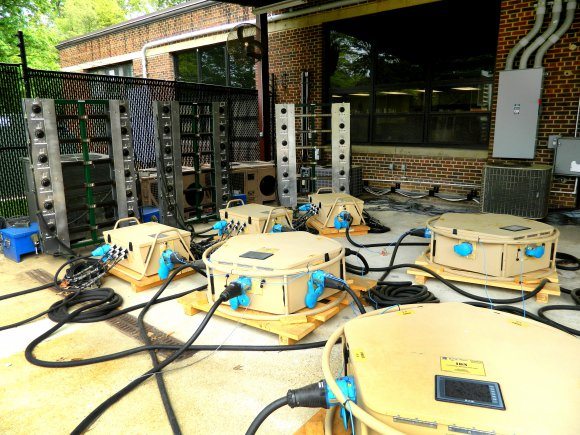U.S. Army engineers are leading research on tactical microgrids to deliver more efficient power to Soldiers across combat zones.
These microgrids are designed and built to provide power independently of traditional grids and to integrate multiple sources of energy for use and storage.
DESIGNING POWER SOLUTIONS FOR COMBAT
The U.S. Army Research, Development and Engineering Command is developing microgrid technologies specifically to meet requirements unique to the battlefield, said Christopher Wildmann, an electrical engineer with RDECOM’s Communications–Electronics Research, Development and Engineering Center at Fort Belvoir, Va.
“CERDEC is one of the first and leading organizations to develop tactical microgrid technologies,” he said. “Technologies on the forefront of the battlefield have to be very small and lightweight, which raises new challenges to the microgrid market.
“All other microgrid efforts going on in [the Department of Defense] are for installations. They are larger systems where tactical mobility is not a requirement.”
Wildmann directly supports Project Manager Mobile Electric Power, the military’s procurement and support agency for electric power generation on tactical battlefields, in the research and development of technologies for transition to production.
“The work in tactical microgrids has been a new challenge to the DOD and industry because of the strict environmental and ruggedness requirements,” he said. “Installation microgrid projects in industry don’t have those requirements. They can use a lot of [commercial off-the-shelf] components since there are no restrictions on size, weight and mobility.”
IMPROVING ENERGY EFFICIENCY
RDECOM’s primary goals in this field are to improve the efficiency and reliability of tactical power grids through the implementation of intelligence into power distribution systems. RDECOM aims to accomplish this through networking power assets together and being able to select the most efficient source for the load demanded.
Microgrid testing has yielded positive results, said Wildmann, who has worked with CERDEC’s Army Power Division for six years.
“We’ve been able to demonstrate these technologies and prove they are ready for production. Last year, we developed a microgrid [for a] demonstration at Fort Devens, Massachusetts,” he said. “The system was able to network multiple generators together and demonstrate a 37 percent reduction in fuel consumption by intelligently managing those existing sources based on the load.
“CERDEC also manages the hybrid intelligent power program, which is a tactical microgrid program to build a standardized system that utilizes all power generating assets on the battlefield to make grids more efficient.”
MATCHING SOLUTIONS TO BATTLEFIELD CONDITIONS
Because of transient conditions in the field, engineers must account for different scenarios during the research and development process, Wildmann said.
“A multitude of solutions is the best way to meet those different conditions,” he said.
Fossil-fueled generator sets are the primary source of power for the Army; however, CERDEC is developing solutions that use renewable power sources, he said.
For larger mobile tactical grids where generators are the primary source of power, advancements are necessary to make renewable power sources lighter, smaller, more power dense and easier to transport before they become a viable solution for tactical microgrids.
For smaller, more remote applications, CERDEC is developing hybrid trailer systems that use renewable power sources and can drastically reduce fuel consumption.
“For very remote operations where we want to reduce fuel as much as possible, renewables and hybrid solutions with batteries might be the best solutions,” he said. “For closer-in grids and units that have access to fuel, we are developing microgrid technologies to make grids as efficient and reliable as possible. Not one technology can be applied to all conditions.”
Emerging power and energy technologies also hold promise for further reductions in fuel consumption when Soldiers are not connected to permanent, reliable power grids. He said one possibility is the Stirling engine driven generator, which could be quieter, more efficient and require less maintenance than the typical internal combustion engine.
“The products we are working here within CERDEC can be very beneficial in the future to microgrids. For example, [we could use] fuel cells, smaller generators, or Stirling power systems. At some point, [these alternatives] can be implemented into a microgrid to further reduce fuel [requirements],” he said.











